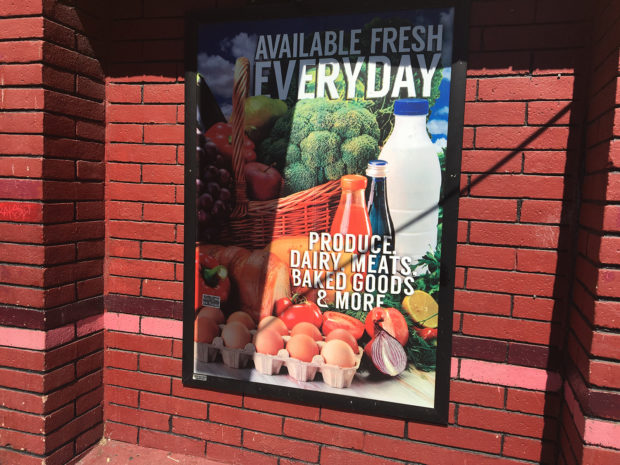
Study reveals reasons behind Richmond food desert

Poster outside Richmond's corner store. Photo by Julia Vassey
By Julia Vassey
A poster outside the entrance to Browns Market on Barrett Avenue shows peppers, tomatoes and broccoli. “Available fresh every day,” it says.
Inside the store, customers see a different picture: canned beans, bottles of sodas and bags of chips—but no vegetables or fruit.
The shop is one of about 50 that Irene Perdomo, Director of Projects and Programs at Mayor Tom Butt’s office, visited this summer as she and a team of 15 high-school volunteers carried out Richmond’s first “food census”—a survey of the items on offer at Richmond’s supermarket, grocery and convenience stores.
Perdomo and her team conducted the survey to identify what specific problems contribute to Richmond’s reputation as a “food desert,” defined by the American Nutrition Association as a city, neighborhood or region “vapid of fresh fruit, vegetables, and other healthful whole foods, usually found in impoverished areas.” The approach was similar to projects in neighboring cities, such as the HOPE Collaborative’s Healthy Corner Store Project in Oakland, said Nadia Barhoum, a researcher at UC Berkeley’s Haas Institute who advised the Richmond survey takers.
At Browns Market, owner Sam Algazali said he phased fresh produce out of his store three years ago, because low demand was losing him money.
“Many people in Richmond shop with food stamps,” Algazali said. “But I don’t have a license and a machine to accept food stamps, so fewer customers were coming and purchasing groceries, which were getting rotten and thrown away,” he said.
This is just one reason Richmond food-store owners offered Perdomo and her team when explaining why they don’t carry healthier food choices. Some blamed things like broken refrigerators, while others blamed spaces too small to make room for fresh goods.
It took the survey team about a month to visit the 50 stores. Each shop owner filled out a questionnaire on the variety of foods they carried, and why they carried some foods (like soda) and not others (like fresh milk).
The census team took notes on prices, advertising, the availability of ethnic grocery items, and asked why some owners were not using the Electronic Benefits Transfer system (EBT) machines that accepted such public assistance programs as CalFresh (formerly known as food stamps). In California, all authorized CalFresh retailers are required to buy the machines. But the application process to get the machines, Algazali said, is confusing.
“I’m not internet savvy, but everything is online now and it is hard to get hold of a customer service representative on the phone to help with the application,” he said.
Other Richmond store owners are taking steps to overcome the barriers to offering healthier foods.
Pakistani-native Anwar Imtair, the owner of Mom and Pop’s and Son’s Market on Fred Jackson Way has invested about $150,000 to renovate his store. This includes a brand-new kitchen in which falafel, humus and fresh burritos will be prepared.
But Imtair said that the most significant change was his decision to stop selling alcohol and tobacco.
Alcohol and fresh produce, Imtair said, attract different customers. When there was liquor on the shelves, “drunk people used to hang out here all the time,” he said. Since he changed the offerings, not only has the store earned a reputation for being family friendly, but the area around it has become safer, he said.
Survey answers from shop owners like Algazali and Imtair will help the mayor’s office identify exactly what local stores need in order to provide more nutritious options.
Imtair, for example, wants to start selling locally-grown fruit and vegetables rather than bringing them from Oakland, as he does now. He said he needs funding for the venture and is currently discussing financial opportunities with the mayor’s office.
The City of Richmond plans to publish the survey’s results in late October or November, Perdomo said. By then, she said, the city will hopefully have some concrete plans for gradually turning Richmond’s food desert into a food paradise.
|

